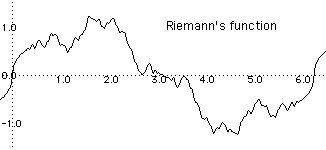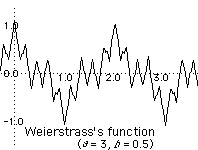 (f (x) - g(x))2dx]1/2.
(f (x) - g(x))2dx]1/2.If a, b are fixed real numbers, calculate d2(x2, ax + b). Use the usual method for finding the turning points of a function of two variables to find the values of a, b for which this distance is a minimum.
[This is the process of linear regression which is important in many areas of applied mathematics and statistics.]
 Mn is convergent, prove that the partial sums of the series
Mn is convergent, prove that the partial sums of the series  fn(x) are uniformly convergent to a continuous function.
fn(x) are uniformly convergent to a continuous function.[Hint: Show that the sequence of partial sums of
 fn(x) are a Cauchy sequence in C[0,1] and then use the result about completeness of this space.]
fn(x) are a Cauchy sequence in C[0,1] and then use the result about completeness of this space.]This result is known as the Weierstrass M-test after the German mathematician Karl Weierstrass (1815 to 1897).
In 1861 the German mathematician Bernhard Riemann (1826 to 1866) studied the function given by the series
 sin(n2x)/n2 and tried to show that it was a continuous function whose derivative did not exist at any point. Use the last result to prove that this series does define a continuous function.
sin(n2x)/n2 and tried to show that it was a continuous function whose derivative did not exist at any point. Use the last result to prove that this series does define a continuous function.In fact this function is differentiable, though only at a countable subset of points. In 1872 Weierstrass defined the function
 bncos(anx) where 0 < b < 1 and a is an odd positive integer with ab > 1. He was able to prove that it is differentiable nowhere. Use the Weierstrass M-test to prove that it is continuous. This was the first such function to be discovered.
bncos(anx) where 0 < b < 1 and a is an odd positive integer with ab > 1. He was able to prove that it is differentiable nowhere. Use the Weierstrass M-test to prove that it is continuous. This was the first such function to be discovered.


Prove that d is a metric on Z. This is called the 2-adic metric.
Prove that the sequence (1, 2, 4, 8, 16, ...) converges to 0 in this metric.
The mathematician Kurt Hensel (1861 - 1941, born in what was Königsberg in Germany and is now Kaliningrad in Russia) used ideas like this to prove results in Number Theory.